Otolith Microchemistry Reveals Life History and Habitat Use of Coilia nasus from the Dayang River of China
Abstract
1. Introduction
2. Materials and Methods
2.1. Study Sites and Fish Sampling
2.2. Otolith Preparation and Microchemical Analysis
2.3. Otolith Age Determination
2.4. Data Analysis
3. Results
4. Discussion
5. Conclusions
Author Contributions
Funding
Institutional Review Board Statement
Data Availability Statement
Acknowledgments
Conflicts of Interest
References
- Jiang, T.; Yang, J.; Liu, H.B.; Shen, X. Life history of Coilia nasus from the Yellow Sea inferred from otolith Sr:Ca ratios. Environ. Biol. Fish. 2012, 95, 503–508. [Google Scholar] [CrossRef]
- Chen, T.T.; Jiang, T.; Liu, H.B.; Li, M.M.; Yang, J. Do all long supermaxilla-type estuarine tapertail anchovies (Coilia nasus Temminck et Schlegel, 1846) migrate anadromously? J. Appl. Ichthyol. 2017, 33, 270–273. [Google Scholar] [CrossRef]
- Khumbanyiwa, D.D.; Li, M.M.; Jiang, T.; Liu, H.B.; Yang, J. Unraveling habitat use of Coilia nasus from Qiantang River of China by otolith microchemistry. Reg. Stud. Mar. Sci. 2018, 18, 122–128. [Google Scholar] [CrossRef]
- Liu, H.B.; Jiang, T.; Yang, J. Unravelling habitat use of Coilia nasus from the Rokkaku River and Chikugo River estuaries of Japan by otolith strontium and calcium. Acta Oceanol. Sin. 2018, 37, 52–60. [Google Scholar] [CrossRef]
- Itakura, H.; Yokouchi, K.; Kanazawa, T.; Matsumoto, M.; Matoba, T.; Wakiya, R.; Shirai, K.; Ishimatsu, A. Diverse downstream migration patterns of the anadromous Japanese grenadier anchovy Coilia nasus in the Chikugo River estuary and Ariake Sea, Japan. Reg. Stud. Mar. Sci. 2020, 39, 101436. [Google Scholar] [CrossRef]
- Jo, S.G.; Yoon, J.M. Genetic distances between tailfin anchovy (Coilia nasus) populations analyzed by PCR. Dev. Reprod. 2021, 25, 59–65. [Google Scholar] [CrossRef]
- Dou, S.Z.; Yokouchi, K.; Yu, X.; Cao, L.; Kuroki, M.; Otake, T.; Tsukamotoet, K. The migratory history of anadromous and non-anadromous tapertail anchovy Coilia nasus in the Yangtze River Estuary revealed by the otolith Sr:Ca ratio. Environ. Bio. Fish. 2012, 95, 481–490. [Google Scholar] [CrossRef]
- Tian, S.Q.; Tian, Z.Q.; Gao, C.X.; Dai, X.J. Analyzing of annual changes for the stock status of Coilia nasus in fishing season in Yangtze River estuary. J. Shanghai Ocean Univ. 2014, 23, 245–250. [Google Scholar]
- Guo, H.Y.; Zhang, X.G.; Tang, W.Q.; Li, H.H.; Shen, L.H.; Zhou, T.S.; Liu, D. Temporal variations of Coilia nasus catches at Jingjiang section of the Yangtze River in fishing season in relation to environmental factors. Resour. Environ. Yangtze Basin. 2016, 25, 1850–1859. [Google Scholar] [CrossRef]
- Beger, M.; Grantham, H.S.; Pressey, R.L.; Wilson, K.A.; Peterson, E.L.; Dorfman, D.; Mumby, P.J.; Lourival, R.; Brumbaugh, D.R.; Possingham, H.P. Conservation planning for connectivity across marine, freshwater, and terrestrial realms. Biol. Conserv. 2010, 143, 565–575. [Google Scholar] [CrossRef]
- Bounket, B.; Tabouret, H.; Gibert, P.; Bareille, G.; Pecheyran, C.; Carrel, G.; Argillier, C.; Morat, F. Spawning areas and migration patterns in the early life history of Squalius cephalus (Linnaeus, 1758): Use of otolith microchemistry for conservation and sustainable management. Aquat. Conserv. 2021, 31, 2772–2787. [Google Scholar] [CrossRef]
- Elsdon, T.S.; Wells, B.K.; Campana, S.E.; Gillanders, B.M.; Jones, C.M.; Limburg, K.E.; Secor, D.H.; Thorrold, S.R.; Walther, B.D. Otolith chemistry to describe movement and life-history parameters of fishes: Hypotheses assumptions, limitation and inferences. Oceanogr. Mar. Biol. 2008, 46, 297–330. [Google Scholar] [CrossRef]
- Carlson, A.K.; Phelps, Q.E.; Graeb, B.D.S. Chemistry to conservation: Using otoliths to advance recreational and commercial fisheries management. J. Fish Biol. 2017, 90, 505–527. [Google Scholar] [CrossRef]
- Hussy, K.; Limburg, K.E.; Pontual, H.D.; Thomas, O.R.B.; Cook, P.K.; Heimbrand, Y.; Blass, M.; Sturrock, A.M. Trace element patterns in otoliths: The role of biomineralization. Rev. Fish. Sci. Aquac. 2020, 29, 445–477. [Google Scholar] [CrossRef]
- Izzo, C.; Reis-Santos, P.; Gillanders, B.M. Otolith chemistry does not just reflect environmental conditions: A meta-analytic evaluation. Fish Fish. 2018, 19, 441–454. [Google Scholar] [CrossRef]
- Tian, H.L.; Liu, J.H.; Cao, L.; Dou, S.Z. Interactive effects of strontium and barium water concentration on otolith incorporation in juvenile flounder Paralichthys olivaceus. PLoS ONE 2019, 14, e0218446. [Google Scholar] [CrossRef]
- Campana, S.E.; Thorrold, S.R. Otoliths, increments, and elements: Keys to a comprehensive understanding of fish populations? Can. J. Fish. Aquat. Sci. 2001, 58, 30–38. [Google Scholar] [CrossRef]
- Arai, T.; Chino, N. Influence of water salinity on the strontium: Calcium ratios in otoliths of the giant mottled eel, Anguilla marmorata. Environ. Biol. Fish. 2016, 100, 281–286. [Google Scholar] [CrossRef]
- Yang, J.; Jiang, T.; Liu, H. Are there habitat salinity markers of the Sr:Ca ratio in the otolith of wild diadromous fishes? A literature survey. Ichthyol. Res. 2011, 58, 291–294. [Google Scholar] [CrossRef]
- Xiong, Y.; Yang, J.; Jiang, T.; Liu, H.B.; Zhong, X.M.; Tang, J.H. Early life history of the small yellow croaker (Larimichthys polyactis) in sandy ridges of the South Yellow Sea. Mar. Biol. Res. 2017, 13, 993–1002. [Google Scholar] [CrossRef]
- Jiang, T.; Liu, H.B.; Huang, H.H.; Yang, J. Migration patterns and habitat use of the tapertail anchovy Coilia mystus in the Oujiang River Estuary and the Zhujiang River Estuary, China. Acta Oceanol. Sin. 2019, 38, 35–40. [Google Scholar] [CrossRef]
- Wu, T.; Zhao, D.Z.; Zhang, F.S.; Wei, B.Q. Changes of wetland landscape pattern in Dayang River Estuary based on high-resolution remote sensing image. Chin. J. Appl. Ecol. 2011, 22, 1833–1840. [Google Scholar] [CrossRef]
- Shi, W.L. Fish fauna characteristics of Dayang River and its adjacent rivers. Fish. Sci. 1985, 4, 53 57+52. (In Chinese) [Google Scholar] [CrossRef]
- Wei, H.X.; Yang, P.M.; Jiang, X.H.; Kou, L.X. Study on community characteristics of plankton in Coilia nasus migratory section of Dayang river. J. Aquac. 2021, 42, 29–36. [Google Scholar] [CrossRef]
- Li, Y.; Chen, J.H.; Feng, G.P.; Yang, J.; Zhao, F.; Shen, C.C.; Song, C.; Jiang, T. Otolith microchemistry assessment: Evidence of migratory Coilia nasus of Yangtze River living in the Shengsi Sea area. Fishes 2022, 7, 172. [Google Scholar] [CrossRef]
- Jiang, T.; Zhou, X.Q.; Liu, H.B.; Liu, H.Z.; Yang, J. Two microchemistry patterns in otoliths of Coilia nasus from Poyang Lake, China. J. Fish. China 2013, 37, 239–244. [Google Scholar] [CrossRef]
- Cong, X.R.; Li, Q.X.; Dong, G.C.; Yang, J.; Jiang, T. Anadromous tapertail anchovy Coilia nasus is still found in Dongping Lake. Chin. J. Fish. 2019, 32, 55–59. [Google Scholar]
- Ma, C.Y. A Study on Molecular Phylogeny of Engraulidae and Population Genetic Diversity of C. mystus and C. ectenes. Ph.D. Thesis, East China Normal University, Shanghai, China, 2010. [Google Scholar]
- Zhang, S.S. The Genetic Diversity Study of Coilia nasus of Liaoning Province in China. Master’s Thesis, Dalian Ocean University, Dalian, China, 2016. [Google Scholar]
- Zhang, J.; Yang, P.M.; Hu, Z.Y.; Jiang, X.H.; Wang, J.J. Reproductive biology of Coilia nasus in Dayang River. Freshw. Fish. 2021, 51, 91–96. [Google Scholar] [CrossRef]
- Jiang, T.; Liu, H.B.; Xuan, Z.Y.; Chen, X.B.; Yang, J. Classification of ecomorphotypes of Coilia nasus from the middle and lower reaches of the Yangtze River Basin. J. Lake Sci. 2020, 32, 518–527. [Google Scholar] [CrossRef]
- Xu, G.C.; Nie, Z.J.; Zhang, C.X.; Wei, G.L.; Xu, P.; Gu, R.B. Histological studies on testis development of Coilia nasus under artificial farming conditions. J. Huazhong Agric. Univ. 2012, 31, 247–252. [Google Scholar] [CrossRef]
- Xu, G.C.; Wan, J.J.; Gu, R.B.; Zhang, C.X.; Xu, P. Morphological and histological studies on ovary development of Coilia nasus under artificial farming conditions. J. Fish. Sci. China 2011, 18, 537–546. [Google Scholar] [CrossRef]
- Yang, J.; Arai, T.; Liu, H.; Miyazaki, N.; Tsukamoto, K. Reconstructing habitat use of Coilia mystus and Coilia ectenes of the Yangtze River estuary, and of Coilia ectenes of Taihu Lake, based on otolith strontium and calcium. J. Fish Biol. 2006, 69, 1120–1135. [Google Scholar] [CrossRef]
- Sokta, L.; Jiang, T.; Liu, H.B.; Xuan, Z.Y.; Qiu, C.; Chen, X.B.; Yang, J. Loss of Coilia nasus habitats in Chinese freshwater lakes: An otolith microchemistry assessment. Heliyon 2020, 6, e04571. [Google Scholar] [CrossRef] [PubMed]
- Li, Y.X.; Xie, S.G.; Li, Z.J.; Cong, W.B.; He, W.P. Gonad development of an anadromous fish Coilia ectenes (Engraulidae) in lower reach of Yangtze River, China. Fish. Sci. 2007, 73, 1224–1230. [Google Scholar] [CrossRef]
- Diana, J.S.; Hanchin, P.; Popoff, N. Movement patterns and spawning sites of muskellunge Esox masquinongy in the Antrim chain of lakes, Michigan. Environ. Biol. Fish. 2014, 98, 833–844. [Google Scholar] [CrossRef]
- Jiang, T.; Yang, J.; Lu, M.J.; Liu, H.B.; Chen, T.T.; Gao, Y.W. Discovery of a spawning area for anadromous Coilia nasus Temminck et Schlegel, 1846 in Poyang Lake, China. J. Appl. Ichthyol. 2017, 33, 189–192. [Google Scholar] [CrossRef]
- Xue, X.P.; Peng, Y.X.; Fang, D.A.; Xu, D.P.; Wang, X.H.; Ren, K.C. Preliminary study of Coilia nasus spawning grounds at Sutong section in the lower reaches of the Yangtze River. J. Fish. China 2022, 46, 1377–1388. [Google Scholar] [CrossRef]
- Liu, Y.; Ren, P.; Yang, X.W.; Li, X.F.; Xu, D.P.; Fang, D.A. Spatial and temporal distribution of larvae and juveniles Coilia nasus in the lower reaches of the Yangtze River. J. Lake Sci. 2020, 32, 506–517. [Google Scholar] [CrossRef]
- Rao, Y.Y.; Zhong, J.S.; Liu, H.; Li, L.F.; Chen, W. Annual variation of the resources of Coilia nasus larvae and juveniles in the southern branch of the Yangtze River estuary. J. Shanghai Ocean Univ. 2021, 30, 828–836. [Google Scholar] [CrossRef]
- Jiang, T.; Liu, H.; Shen, X.; Shimasaki, Y.; Oshima, Y.; Yang, J. Life history variations among different populations of Coilia nasus along the Chinese coast inferred from otolith microchemistry. J. Fac. Agric. Kyushu Univ. 2014, 59, 383–389. [Google Scholar] [CrossRef]
- Li, Y.X.; He, W.P.; Liu, J.S.; Li, Z.J.; Xie, S.G. Annulus validation and age and growth estimation of anadromous Coilia ectenes in the Yangtze Estuary. Acta Hydrobiol. Sin. 2010, 34, 787–793. [Google Scholar] [CrossRef]
- Wang, H.F.; Li, Z.Y.; Tian, J.; Sun, L.; Tan, X.Q.; Holi, J. Transplant of Oncorhynchus in Dayang River of the Yellow Sea northern shore. J. Fish. China 2004, 3, 347–351. [Google Scholar]
- Li, Z.H.; Li, G.; Li, S.; Jiang, Z.Q.; Sun, S.H. Study on short-distance transportation and overwintering technologies of Colia nasus fries in artificial breeding from Dayang River. J. Anhui Agric. Sci. 2018, 46, 96 97+108. [Google Scholar] [CrossRef]
- Jiang, T.; Liu, H.B.; Li, M.M.; Yang, J. Investigation on shrimp feeding of Coilia nasus during its anadromous migration along the Yangtze River. J. Lake Sci. 2018, 30, 458–463. [Google Scholar] [CrossRef][Green Version]
- Ma, F.J.; Yin, D.H.; Fang, D.A.; Yang, Y.P.; Jiang, M.; You, L.; Tian, J.L.; Xu, P.; Liu, K. Insights into response to food intake in anadromous Coilia nasus through stomach transcriptome analysis. Aquac. Res. 2020, 51, 2799–2812. [Google Scholar] [CrossRef]
- McBride, R.S.; Somarakis, S.; Fitzhugh, G.R.; Albert, A.; Yaragina, N.A.; Wuenschel, M.J.; Alonso-Fernández, A.; Basilone, G. Energy acquisition and allocation to egg production in relation to fish reproductive strategies. Fish Fish. 2015, 16, 23–57. [Google Scholar] [CrossRef]
- Yokouchi, K.; Fukuda, N.; Shirai, K.; Aoyama, J.; Daverat, F.; Tsukamoto, K. Time lag of the response on the otolith strontium/calcium ratios of the Japanese eel, Anguilla japonica to changes in strontium/calcium ratios of ambient water. Environ. Biol. Fish. 2011, 92, 469–478. [Google Scholar] [CrossRef]
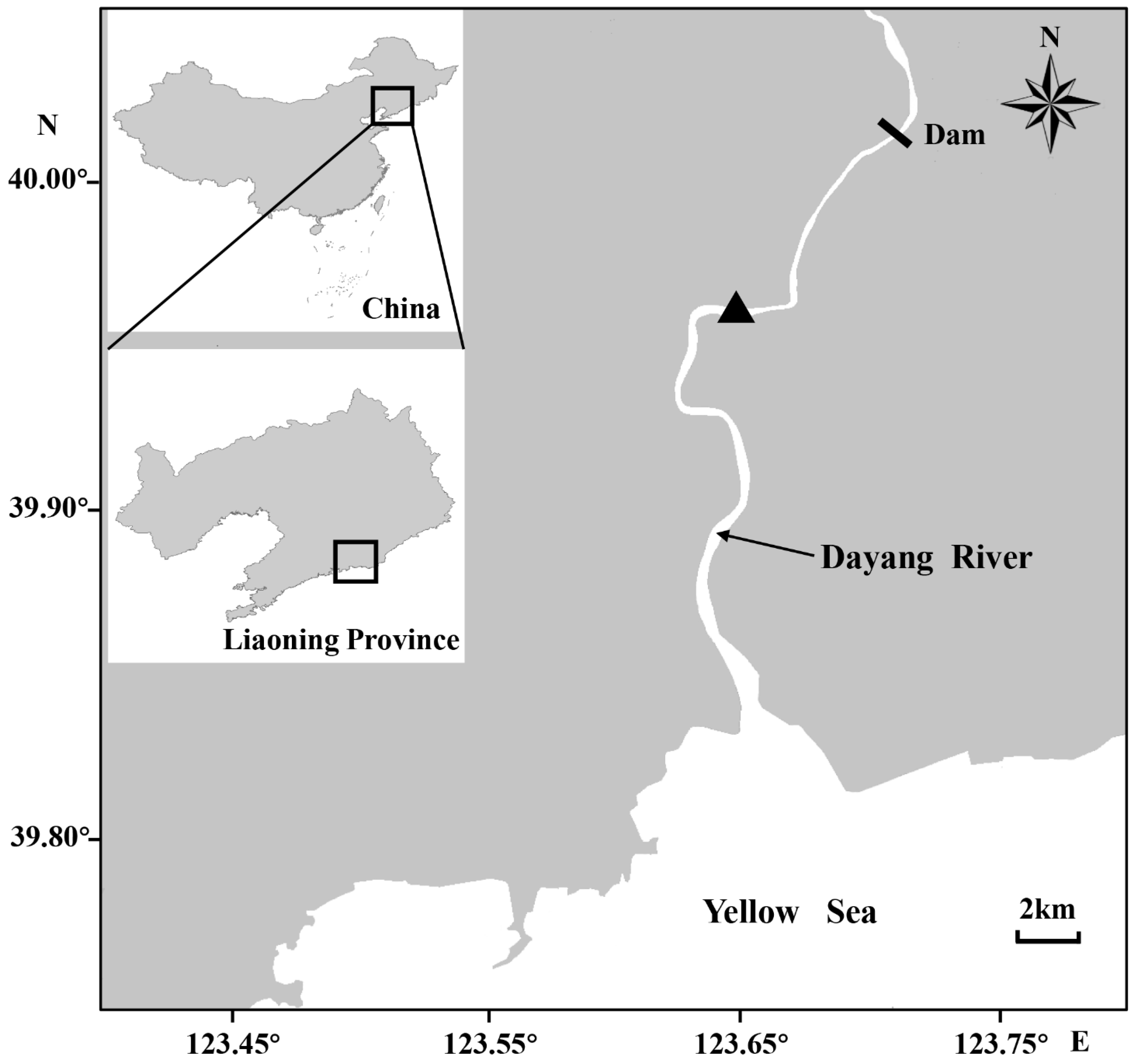
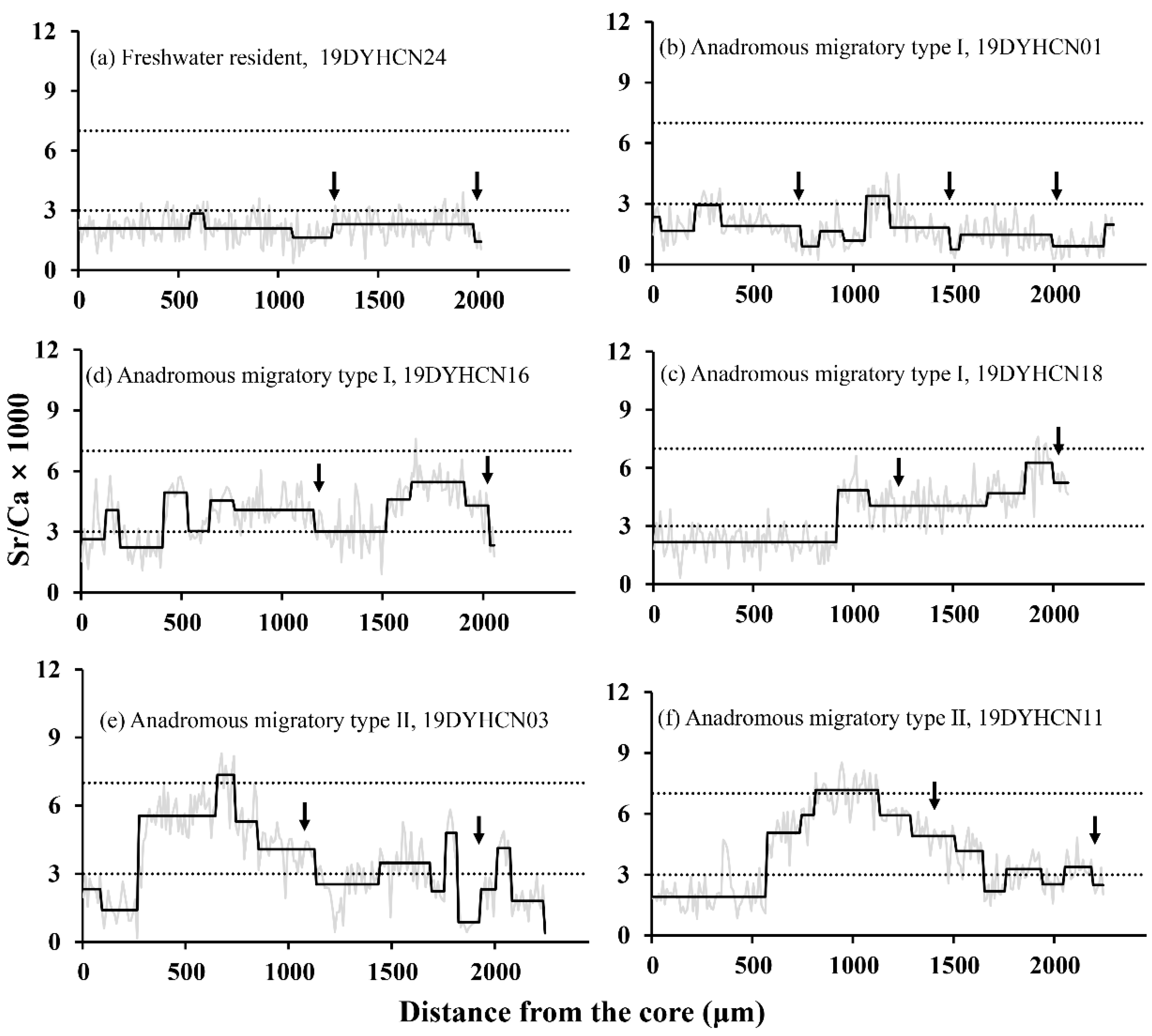
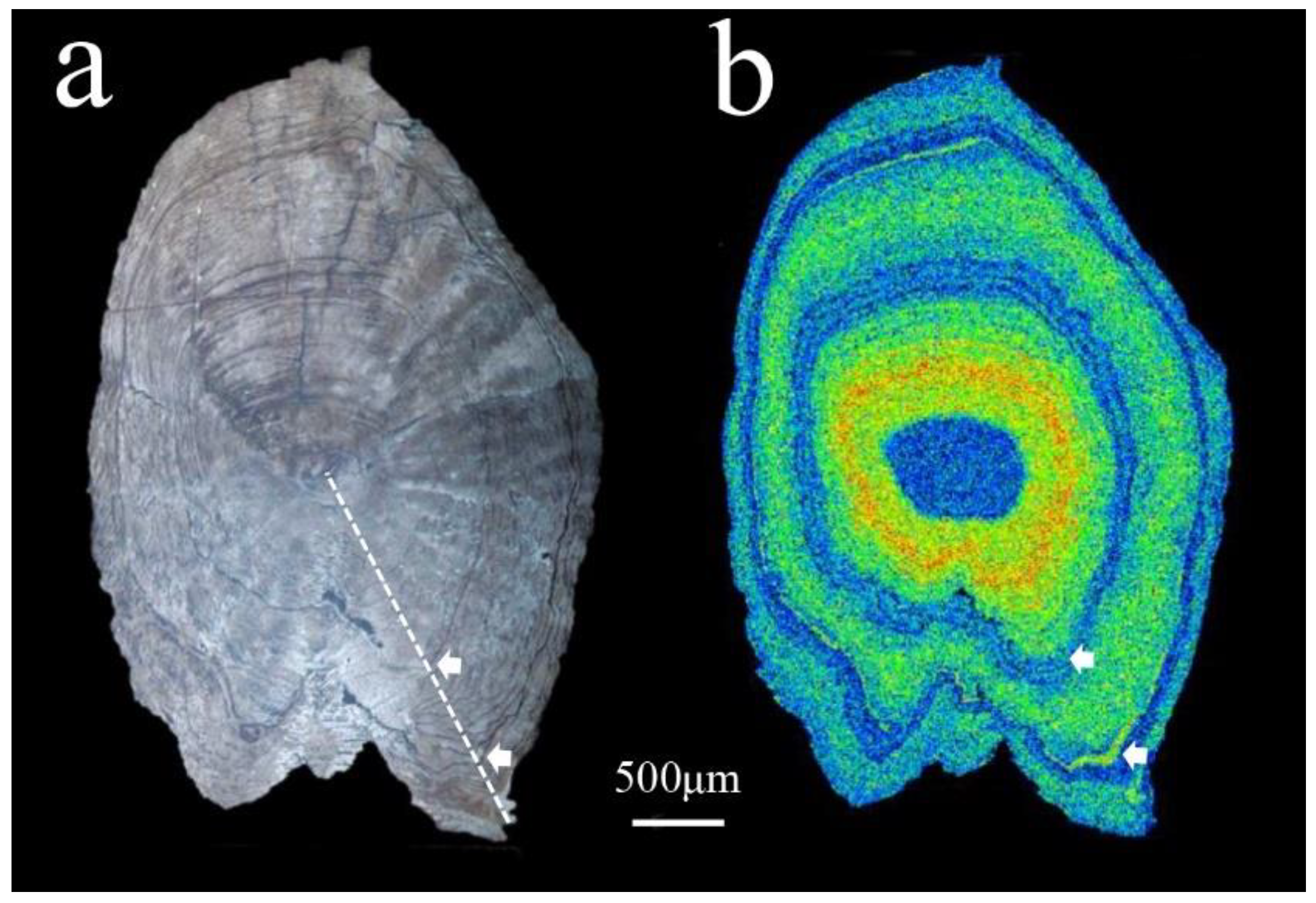
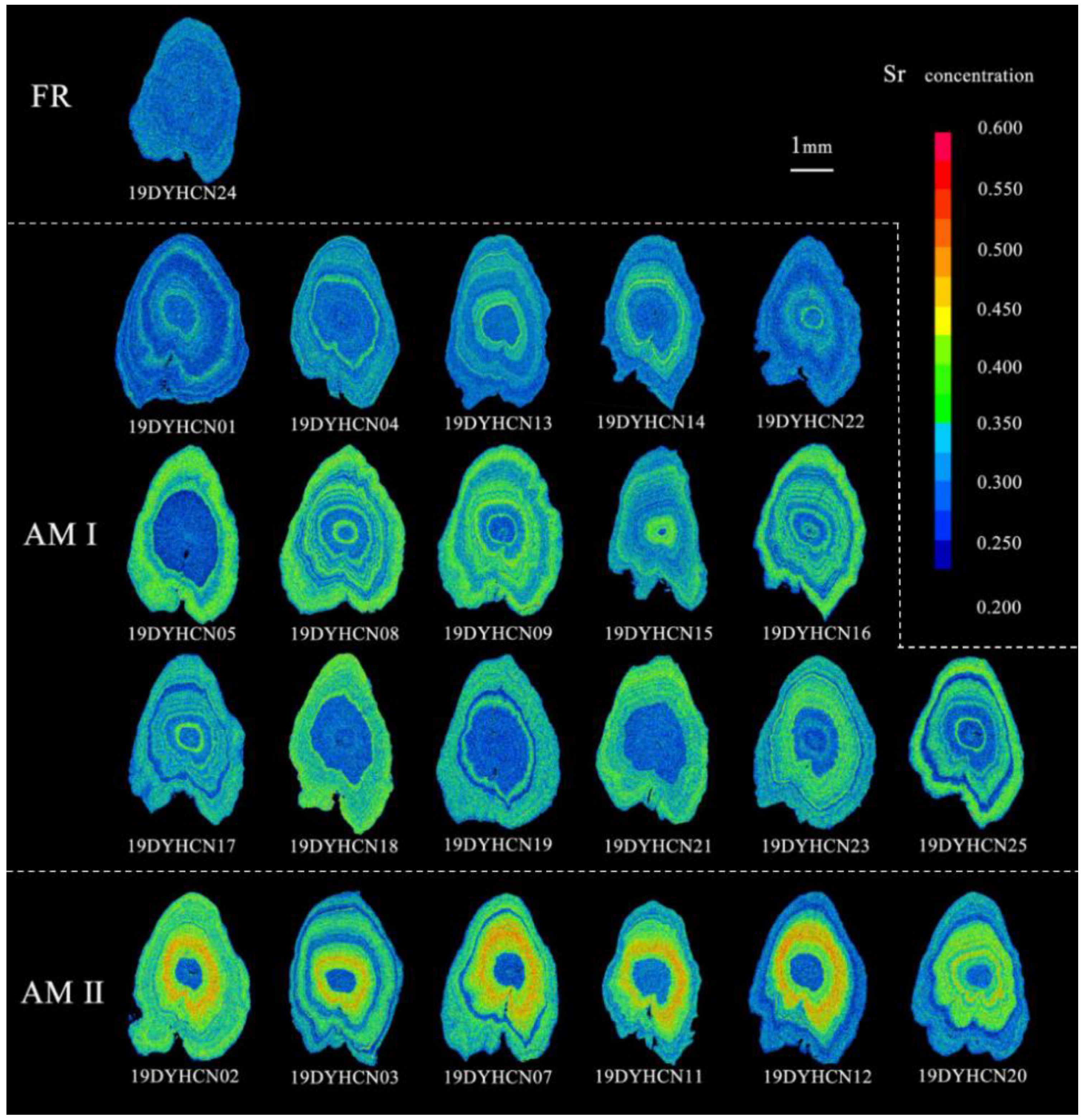
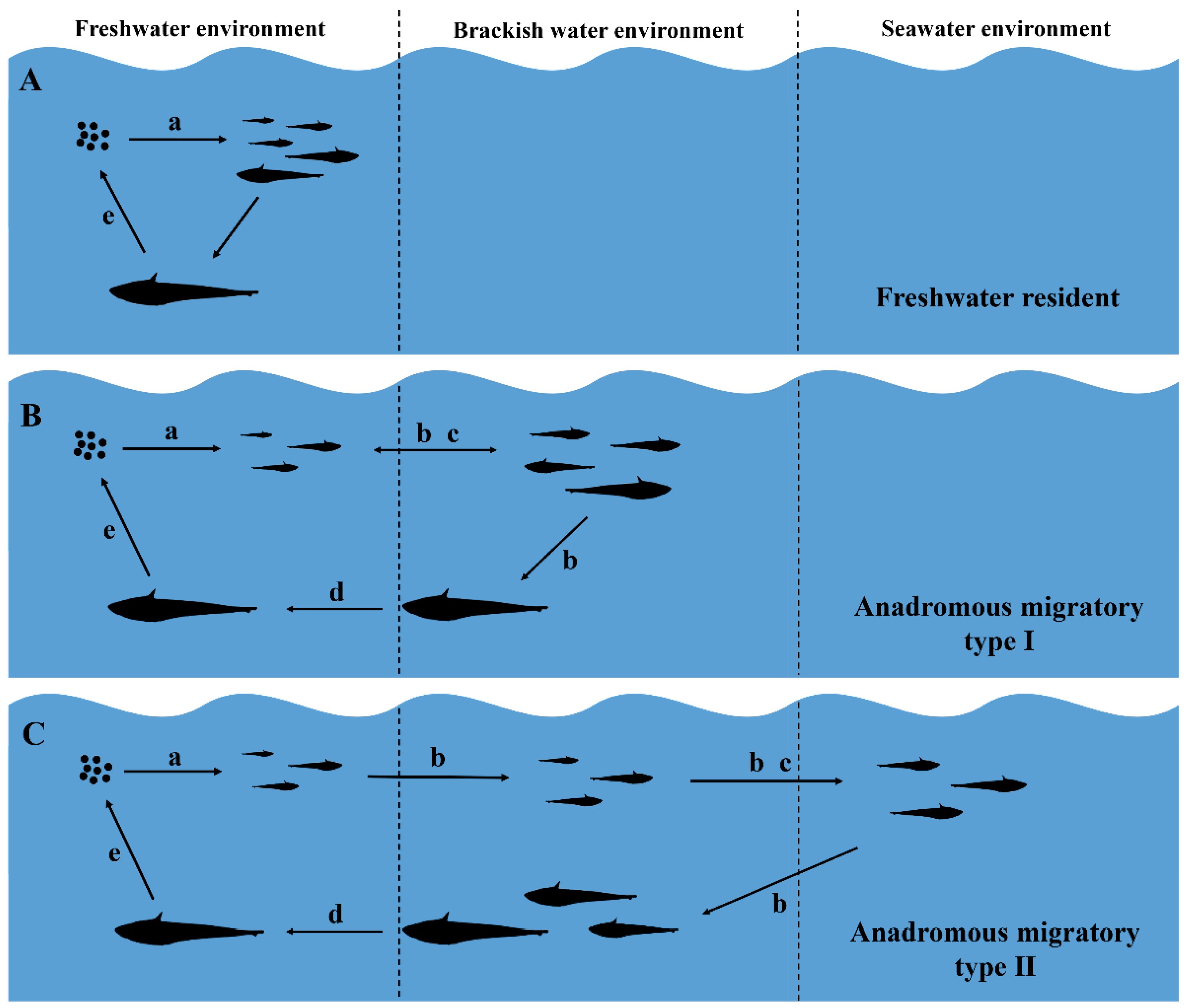
| Sample Code | Body Length (mm) | Body Weight (g) | Jaw Length/Head Length | Sexuality | Sexual Maturity | Inferred Age (year) |
|---|---|---|---|---|---|---|
| 19DYHCN01 | 315 | 106.9 | 1.08 | ♂ | V | 3 |
| 19DYHCN02 | 296 | 103.5 | 1.22 | ♀ | IV | 2 |
| 19DYHCN03 | 312 | 112.8 | 1.21 | ♀ | V | 2 |
| 19DYHCN04 | 292 | 77.8 | 1.22 | ♀ | III | 2 |
| 19DYHCN05 | 268 | 79.8 | 1.15 | ♂ | III | 2 |
| 19DYHCN07 | 267 | 70.5 | 1.28 | ♀ | IV | 2 |
| 19DYHCN08 | 267 | 65.6 | 1.29 | ♀ | IV | 2 |
| 19DYHCN09 | 285 | 75.2 | 1.14 | ♀ | IV | 2 |
| 19DYHCN11 | 265 | 72.9 | 1.27 | ♀ | IV | 2 |
| 19DYHCN12 | 257 | 50.7 | 1.26 | ♂ | IV | 2 |
| 19DYHCN13 | 265 | 57.2 | 1.35 | ♂ | IV | 3 |
| 19DYHCN14 | 269 | 59.2 | 1.21 | ♂ | III | 2 |
| 19DYHCN15 | 270 | 63.6 | 1.26 | ♀ | IV | 2 |
| 19DYHCN16 | 249 | 54.9 | 1.22 | ♂ | IV | 2 |
| 19DYHCN17 | 255 | 55.6 | 1.32 | ♂ | III | 2 |
| 19DYHCN18 | 249 | 50.7 | 1.18 | ♂ | IV | 2 |
| 19DYHCN19 | 231 | 40.7 | 1.24 | ♀ | IV | 2 |
| 19DYHCN20 | 224 | 30.3 | 1.26 | ♂ | III | 2 |
| 19DYHCN21 | 193 | 30.3 | 1.20 | ♂ | IV | 2 |
| 19DYHCN22 | 213 | 34.9 | 1.21 | ♂ | III | 2 |
| 19DYHCN23 | 227 | 33.2 | 1.20 | ♀ | IV | 2 |
| 19DYHCN24 | 214 | 24.7 | 1.19 | ♀ | III | 2 |
| 19DYHCN25 | 217 | 30.4 | 1.22 | ♀ | III | 2 |
Publisher’s Note: MDPI stays neutral with regard to jurisdictional claims in published maps and institutional affiliations. |
© 2022 by the authors. Licensee MDPI, Basel, Switzerland. This article is an open access article distributed under the terms and conditions of the Creative Commons Attribution (CC BY) license (https://creativecommons.org/licenses/by/4.0/).
Share and Cite
Hu, Y.; Jiang, T.; Liu, H.; Chen, X.; Yang, J. Otolith Microchemistry Reveals Life History and Habitat Use of Coilia nasus from the Dayang River of China. Fishes 2022, 7, 306. https://doi.org/10.3390/fishes7060306
Hu Y, Jiang T, Liu H, Chen X, Yang J. Otolith Microchemistry Reveals Life History and Habitat Use of Coilia nasus from the Dayang River of China. Fishes. 2022; 7(6):306. https://doi.org/10.3390/fishes7060306
Chicago/Turabian StyleHu, Yuhai, Tao Jiang, Hongbo Liu, Xiubao Chen, and Jian Yang. 2022. "Otolith Microchemistry Reveals Life History and Habitat Use of Coilia nasus from the Dayang River of China" Fishes 7, no. 6: 306. https://doi.org/10.3390/fishes7060306
APA StyleHu, Y., Jiang, T., Liu, H., Chen, X., & Yang, J. (2022). Otolith Microchemistry Reveals Life History and Habitat Use of Coilia nasus from the Dayang River of China. Fishes, 7(6), 306. https://doi.org/10.3390/fishes7060306








